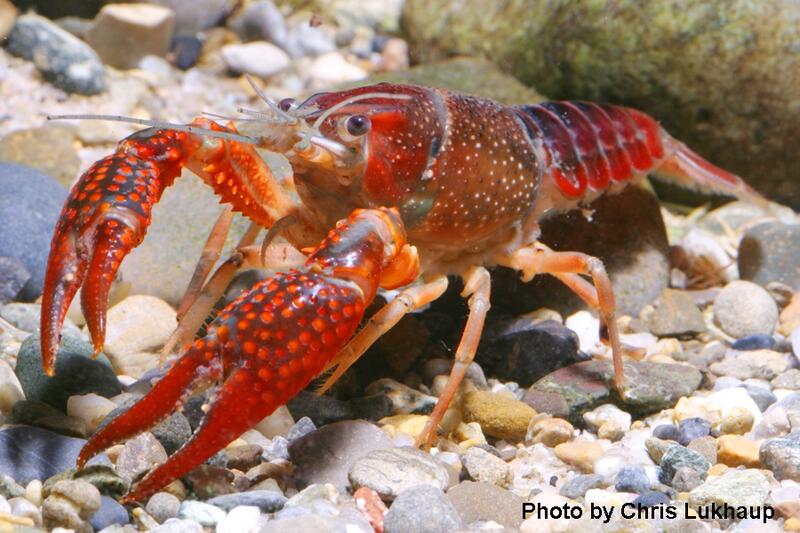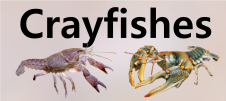







Loading profile. Please wait . . .
Procambarus clarkii (Girard, 1852)
Red Swamp Crayfish




Federal Protection: No US federal protection
State Protection: No Georgia state protection
Global Rank: G5
State Rank: SNA
Element Locations Tracked in Biotics: No
SWAP 2015 Species of Greatest Conservation Need (SGCN): No
SWAP 2025 Species of Greatest Conservation Need (SGCN): No
2025 SGCN Priority Tier: None
Element Occurrences (EOs) in Georgia: 0
Habitat Summary for element in Georgia: Permanent streams and swamps as well as temporary habitats such as ditches and ponds; simple burrows where water has receded
The overall color of the Red Swamp Crawfish includes reds, reddish-browns, and pinkish hues. The back is dark reddish brown to dark red. The sides are pinkish-orangish with white speckles and whitish splotching. There are numerous small, dark tubercles on the carapace. The abdomen has dark transverse bands on each segment which create the appearance of a broad, dark longitudinal stripe. The claws are dark red to blackish with bright orangish-reddish tubercles. Another color form seen on juveniles, females, and smaller males is overall brownish or greenish with dark splotches, white speckles, and dark tubercles. The claws of adult males are similar to the above description but the background color of the claws of juveniles and females may be dark brown. The areola is narrow and often obliterated. The rostrum is long and pointed and often has marginal spines or tubercles, especially on juveniles. A single cervical tubercle is usually present and may be a sharp spine on juveniles. This species reaches a maximum total body length of over 100 mm (>4 in).
Above the Fall Line, there is no other crayfish species in Georgia with orangish-reddish tubercles on the claws. Below the Fall Line this species could be confused with its close relatives Eastern Red Swamp Crawfish (Procambarus troglodytes), Ornate Crayfish (P. howellae), and Peninsula Crayfish (P. paeninsulanus). Details of the male reproductive structure are required to separate these species from one another.
The Red Swamp Crawfish occurs in permanent streams and swamps as well as temporary habitats such as ditches and ponds. In streams it is usually associated with vegetation or woody debris or undercut banks. In areas where open water recedes, it can be found in simple burrows.
Crayfishes are considered opportunistic omnivores and likely feed on live and decaying vegetation, aquatic insect larvae, small fishes, and dead animal matter.
Red Swamp Crawfish live in a variety of habitats and may be found in open water or burrows when water levels drop. Reproduction likely occurs during the spring and fall, but males in reproductive condition may be found at any time during the year. When female crayfish are ready to lay eggs, they usually find a secure hiding place and hence are rarely encountered. After the eggs are released, the female attaches them to her swimmerets and is said to be “in berry.” Upon hatching, the juvenile crayfish are attached to the mother by a thread. After the juveniles molt for the second time, they are free of the mother, but stay close and will hold on to her for some time. Eventually they move off on their own. Crayfishes molt 6 or 7 times during their first year of life and most are probably able to reproduce by the end of that year. They molt once or twice a year for the remainder of their lives and live about 3 years. There is little data on the life history of this species in Georgia. In its native range, breeding probably occurs in the spring and females retreat to burrows to lay eggs and rear young. Males in reproductive condition range in size from about 50 mm (2 in.) to over 100 mm (>4 in.) in total length (Walls 2009).
In streams or ponds, kicking through vegetation into a net can yield specimens. If there are rocks or logs in the creek, they may be carefully lifted and crayfish may be pinned by hand or coaxed into a dipnet. Excavation of burrows adjacent to drying ponds or ditches should also yield specimens. Using a backpack electroshocker or baited minnow traps set overnight may yield specimens as well.
The native distribution of Red Swamp Crawfish ranges from Mexico to the Florida panhandle and the Mississippi River basin north to southern Illinois and Ohio (Hobbs 1989). It has been introduced across the United States and the world as a food resource for people. Hobbs (1981) did not mention it as occurring in Georgia, but it has now been found in the Chattahoochee, Etowah, Flint, upper Ocmulgee, upper Oconee, Oostanaula, upper Satilla, and Savannah river systems. I am aware of three Red Swamp Crawfish production operations which are now closed. They were in Harris County in the Chattahoochee River basin, Berrien County in the Alapaha River basin (Suwannee tributary), and in Camden County in the Satilla River basin. Targeted collections near those areas for Red Swamp Crawfish did not revealed nearby wild populations. The species was recently discovered in a freshwater pond on Little St. Simons Island (Skelton unpubl. data) and will likely be found in additional areas across the state.
Since this species is not native to Georgia, no threats are recognized.
This species is not native to Georgia and should be considered invasive.
This species is commonly used by school systems for educational purposes and also consumed as food. It is possible to have live crayfish shipped anywhere overnight. If this species is used for educational purposes, please humanely euthanize unused specimens by placing them in the freezer for several hours. Under no circumstances should this, or any other crayfish species, be released to the wild or moved from one water body to another. If using crayfish for bait, only use them in the stream in which they were captured. Ideally, any specimens of this species encountered should be collected and humanely euthanized by freezing. Introduction of non-native species is one of the leading causes of native species declines.
Hobbs, H.H., Jr. 1981. The crayfishes of Georgia. Smithsonian Contributions to Zoology 318:1–549.
Hobbs, H. H., Jr. 1989. An illustrated checklist of the American crayfishes (Decapoda: Astacidae, Cambaridae, and Parastacidae). Smithsonian Contributions to Zoology 480:1–236.
Taylor, C.A., G.A. Schuster, J.E. Cooper, R.J. DiStefano, A.G. Eversole, P. Hamr, H.H. Hobbs III, H.W. Robison, C.E. Skelton, and R.F. Thoma. 2007. A reassessment of the conservation status of crayfishes of the United States and Canada after 10+ years of increased awareness. Fisheries 32:372–389. Walls, J.G. 2009. Crawfishes of Louisiana. Louisiana State University Press, Baton Rouge. 240 pp.
Christopher E. Skelton
C. Skelton, August 2012: original account
C. Skelton, March 2019: general update of account.
D.Weiler, September 2019: photo added